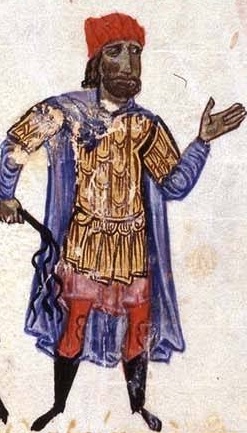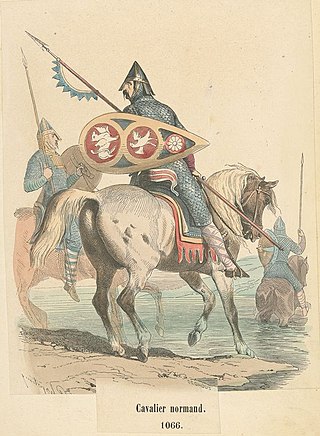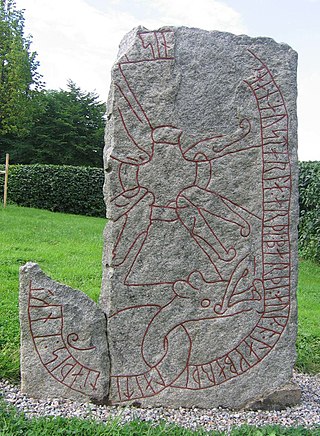
George Maniakes was a prominent general of the Byzantine Empire during the 11th century. He was the catepan of Italy in 1042. He is known as Gyrgir in Scandinavian sagas. He is popularly said to have been extremely tall and well built, almost a giant.

The Varangian Guard was an elite unit of the Byzantine Army from the tenth to the fourteenth century who served as personal bodyguards to the Byzantine emperors. The Varangian Guard was known for being primarily composed of recruits from northern Europe, including mainly Norsemen from Scandinavia but also Anglo-Saxons from England. The recruitment of distant foreigners from outside Byzantium to serve as the emperor's personal guard was pursued as a deliberate policy, as they lacked local political loyalties and could be counted upon to suppress revolts by disloyal Byzantine factions.

The Catepanateof Italy was a province of the Byzantine Empire from 965 until 1071. At its greatest extent, it comprised mainland Italy south of a line drawn from Monte Gargano to the Gulf of Salerno. North of that line, Amalfi and Naples also maintained allegiance to Constantinople through the catepan. The Italian region of Capitanata derives its name from katepanikion.
Argyrus was a Lombard nobleman and Byzantine general, son of the Lombard hero Melus. He was born in Bari.
Michael Dokeianos, erroneously called Doukeianos by some modern writers, was a Byzantine nobleman and military leader, who married into the Komnenos family. He was active in Sicily under George Maniakes before going to Southern Italy as Catepan of Italy in 1040–41. He was recalled after being twice defeated in battle during the Lombard-Norman revolt of 1041, a decisive moment in the eventual Norman conquest of southern Italy. He is next recorded in 1050, fighting against a Pecheneg raid in Thrace. He was captured during battle but managed to maim the Pecheneg leader, after which he was put to death and mutilated.
The Battle of Cannae was a battle that took place in 1018 between the Byzantines under the Catepan of Italy Basil Boioannes and the Lombards under Melus of Bari. The Lombards had also hired some Norman cavalry mercenaries under their leader Gilbert Buatère, while Boioannes had a detachment of elite Varangian Guard sent to him at his request to combat the Normans. The engagement was one of the first clashes between the Romans of southern Italy and the Normans.

Byzantius was the archbishop of Bari in the early eleventh century. He began the construction of the new cathedral, which was continued by his successors.
Exaugustus Boiοannes, son of the famous Basil Boioannes, was also a catepan of Italy, from 1041 to 1042. He replaced Michael Dokeianos after the latter's disgrace in defeat at Montemaggiore on May 4. Boioannes did not have the levies and reinforcements that Doukeianos had had at his command. He arrived only with a Varangian contingent. Boioannes decided on trying to isolate the Lombard rebels in Melfi by camping near Montepeloso.
John Kourkouas or Curcuas was the Byzantine catepan of Italy from 1008–1010.
Alexios Xiphias was a Byzantine protospatharios and catepan of Italy from 1006 to 1007, following the long term of office of Gregory Tarchaneiotes. In March 1007, he promulgated a diploma in favour of Alexander, abbot of San Giovanni in Lamis.
Eustathios Palatinos was the catepan of Italy from the autumn of 1045 to September 1046. The primary source for his term of office is the chronicle of Lupus, a fellow protospatharius.

Pothos Argyros or Argyrus was a Byzantine commander, who served as the catepan of Italy during the eventful years of 1029 to 1031.
The siege of Bari took place 1068–71, during the Middle Ages, when Norman forces, under the command of Robert Guiscard, laid siege to the city of Bari, a major stronghold of the Byzantines in Italy and the capital of the Catepanate of Italy, starting from 5 August 1068. Bari was captured on 16 April 1071 when Robert Guiscard entered the city, ending over five centuries of Byzantine presence in Southern Italy.
John Raphael may refer to:

The Battle of Olivento was fought on 17 March 1041 between the Byzantine Empire and the Normans of southern Italy and their Lombard allies near the Olivento river, between the actual Basilicata and Apulia, southern Italy.

Lucania was a Byzantine province (theme) in southern Italy that was probably established c. 968, under Emperor Nikephoros II Phokas.

The Battle of Montemaggiore was fought on 4 May 1041, on the river Ofanto near Cannae in Byzantine Italy, between Lombard-Norman rebel forces and the Byzantine Empire. The Norman William Iron Arm led the offence, which was part of a greater revolt, against Michael Dokeianos, the Byzantine Catepan of Italy. Suffering heavy losses in the battle, the Byzantines were eventually defeated, and the remaining forces retreated to Bari. Dokeianos was replaced and transferred to Sicily as a result of the battle. The victory provided the Normans with increasing amounts of resources, as well as a renewed surge of knights joining the rebellion.
The Battle of Montepeloso was fought on 3 September 1041 between Lombard-Norman rebel forces and the Byzantine Empire, near Montepeloso in southern Italy. The Byzantines, led by Exaugustus Boioannes, were forced into battle by the rebels, and after a day-long fight the rebels defeated the Byzantine army and captured Boioannes. The decisive rebel victory forced the Byzantines to retreat to the coastal cities, leaving the Normans and Lombards in control of the whole interior of southern Italy.
Abulchares was a Byzantine general of Arab origin who served as the catepan of Italy from 1064 until his death. The chief sources for his catapanate are Skylitzes Continuatus and Anonymi Barensis Chronicon. Skylitzes Continuatus records that Abulchares was also duke (doux) of Dyrrhachium across the Adriatic, but this is chronologically impossible, since Perenos is recorded as duke at this time.
Leo Perenos was a Byzantine governor (doux) of Dyrrhachium, and the penultimate Catepan of Italy.







